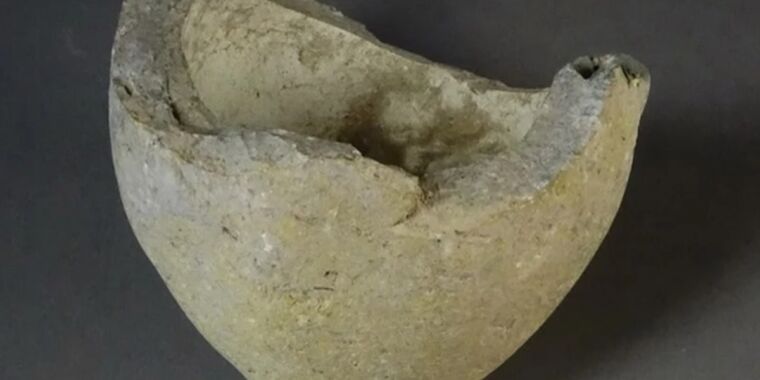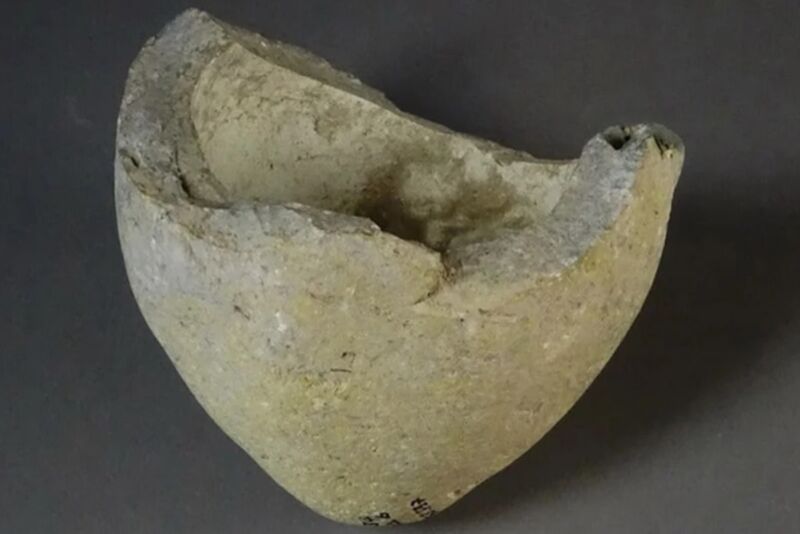
C.D. Matheson et al., 2022
Archaeologists have analyzed the residue inside four medieval ceramic shards and determined that one of them may have been used as a hand grenade, according to a recent paper published in the journal PLOS One. And the explosive used was likely made locally rather than gunpowder imported from China.
Byzantine soldiers used early versions of grenades in the 8th century CE, building on the “Greek fire” invented a century earlier. Instead of using Greek fire with flamethrowers, they placed the incendiary material in small stone or ceramic (and later, glass) jars to create handheld explosives. By the 10th century, the technology had spread to China, with Chinese soldiers packing gunpowder into ceramic or metal containers with a fuse attached.
India likely also had grenade-like weapons. A 12th century manuscript (based on an earlier Sanskrit work) describes a terra-cotta elephant filled with explosives with a fuse that was unleashed on an invading army. A mid-14th century Chinese treatise references a “flying-cloud thunderclap cannon,” described as cast iron shells shaped like a ball and roughly the size of a bowl, filled with gunpowder (“divine fire”). Similar grenades first appeared in Europe in 1467 and have been a staple of warfare since.
So it’s perfectly plausible that grenades were also a fixture of weaponry in 11th and 12th century Jerusalem. According to Carney Matheson, an archaeologist at Griffith University in Australia, and his co-authors on the latest PLOS One paper, small ceramic vessels (ranging from a few centimeters to 20 centimeters in diameter) from the 9th to 15th centuries are frequently found in excavation sites throughout the Middle East. Many have conical bases and spheroid bodies, and the ubiquity of these sphero-conical artifacts suggests the vessels were used for many different functions.
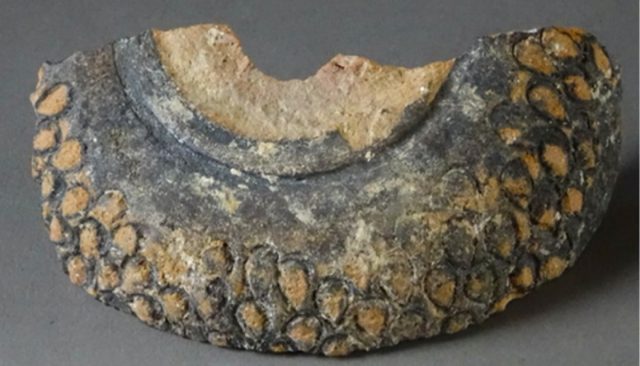
C.D. Matheson et al., 2022
Possible uses included: a plumb bob or a loom weight, a liquid sprinkler, a fire starter, a lamp, a smoking pipe, or parts of an apparatus for distillation. They would also likely have been used as containers, holding wine, honey, beer, medicines, scented oils, holy water, mercury, or perfumes. And there is some evidence in historical documents that such vessels were used as grenades. Residue analysis could help confirm those suggested uses, but per Matheson et al., very few such experiments have been conducted.
So the team decided to analyze the residue on four ceramic vessel shards excavated from the Armenian Gardens in Jerusalem between 1961 and 1967, an area that was also the site of the Crusader royal palace. All shards are housed in the Royal Ontario Museum. One shard (#741) was orange with a reddish-brown interior; shard #742 was gray-green with a pale green inner surface; shard #744 was greenish with a pale grey interior; and shard #737 was dense and gray, both inside and out.
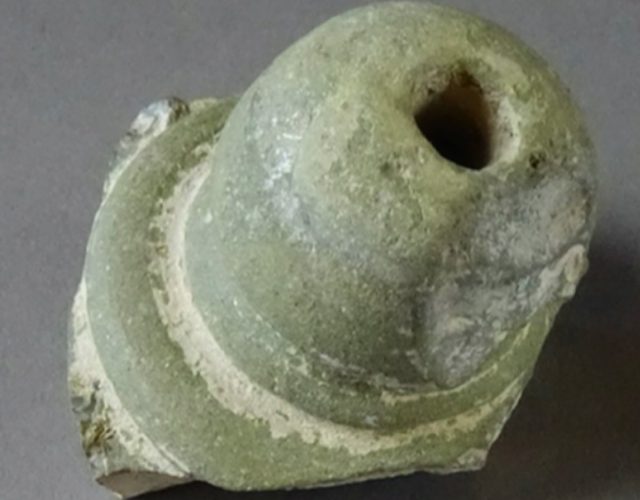
C.D. Matheson et al., 2022
None of the shards had been treated by conservationists other than a light brushing and rinsing with water. Because the artifacts were excavated in the 1960s, Matheson et al. couldn’t take soil samples from the archaeological site. Still, they used existing available data on the composition of soils from that region of Jerusalem—mostly limestone and dolomite with patches of chalk that break down into terra rosa and pale rendzina—for comparison with the residue analyses.
It was shard #737 that proved most interesting to the researchers. The residue contained sulfur and mercury, as well as magnesium, nitrates, phosphorus, calcium (possibly derived from calcium oxide, a component of Greek fire), lead, and iron. Matheson et al. noted that this suggests plant oils, glycerol, and animal fats, consistent with the vessel being used to hold oils, perfumes, or medicines and as a fuel source for a weapon or a lamp.
It may have had multiple uses, but the authors think the possibility it was used as a grenade is worth serious consideration. The thick walls would have been able to withstand the rising pressure before detonation; the vessel was gray and undecorated; its size, shape, and weight are about the optimal size for a handheld grenade of the sort described in historical accounts.
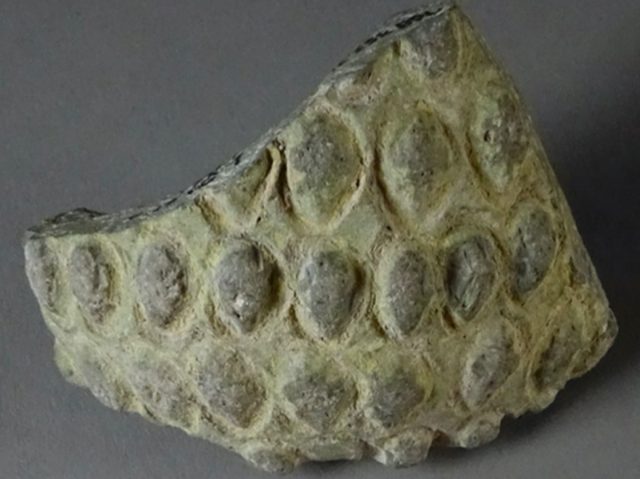
C.D. Matheson et al., 2022
“These vessels have been reported during the time of the Crusades as grenades thrown against Crusader strongholds producing loud noises and bright flashes of light,” said Matheson. “Some researchers had proposed the vessels were used as grenades and held black powder, an explosive invented in ancient China and known to have been introduced into the Middle East and Europe by the 13th century. It has been proposed that black powder may have been introduced to the Middle East earlier, as early as these vessels from the 9th-11th century. However, this research has shown that it is not black powder and likely a locally invented explosive material.”
As for the other three shards, #741’s residue had a few fatty acids and just a small amount of sulfur that may have come from the surrounding soil. The authors concluded that this vessel was likely used as a container for oils. Shard #742’s residue included animal fats, plant oils, resin, salts, and mercury, with a bit of sodium thrown in. The sulfur, mercury, and organic substances indicate the vessel may have held medicines.
Finally, the residue from shard #744 contained plant oils, animal fats, byproducts that may have come from fermentation (to make wine or beer), and sulfur. Matheson et al. concluded it was also used to hold medicines, despite the high amount of sulfur. “Sulphur has been used in alchemy, ancient medicines, and ancient weapons, but it requires an oxidizer as a weapon, and an oxidizer was not identified in this residue,” the authors wrote.
DOI: PLoS ONE, 2022. 10.1371/journal.pone.0267350 (About DOIs).

